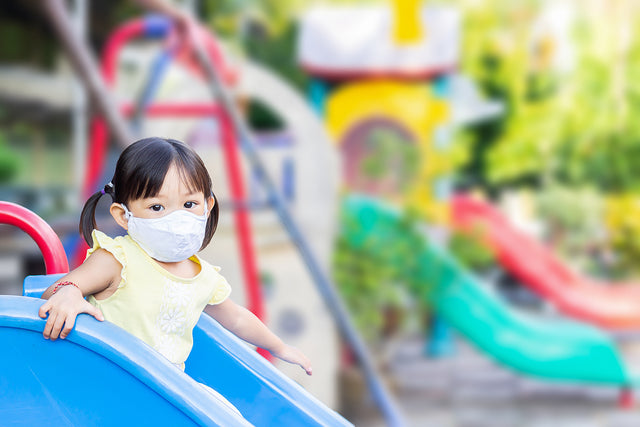Are Playgrounds Safe During COVID-19?

After being cooped up for so many months, parents may have begun to eye playgrounds like a delicious oasis in the middle of the desert. Playgrounds give kids an outlet to run, climb, jump, and scream…in a place that’s designed for them to burn off their energy! But are playgrounds safe during a pandemic? The answer is…a little uncertain right now.
On one hand, it appears that coronavirus is spread more inside than outside. So, playing outdoors is less risky than an indoor playdate. At the same time, playgrounds pose unique problems when it comes to following pandemic precautions.
Young kids may have a hard time following the rules, so enforcing physical distancing and face masks could be a challenge for parents! The nature of a playground is also very hands-on. Even though we’ve learned that coronavirus transmission often happens through airborne particles, it’s also possible to spread it by touch…especially on surfaces that are palmed by lots of little hands. If your child sneezes on her hand or picks her nose (kids will be kids!) before pawing the slide railing, she’s just transferred her germs to the slide railing, making it possible that the next kid climbing up to take his turn will pick them up.
If you are planning on making a trip to the playground, here are a few tips for keeping your family healthy…
Steer clear of packed playgrounds.
If the playground’s hopping…get walking. Depending on how large the space is, if there are 10 or more people present, that should be your cue to come back later. The fewer children that are playing, the easier it will be to maintain a safe distance from others, and the lower your exposure risk. Hit up the playground during times where there aren’t likely to be a ton of families there…maybe first thing in the morning, or on a weekday when other children might be in school.
Sanitize, sanitize, sanitize.
Pack some hand sanitizer with at least 60% alcohol. You may also want to bring along some sanitizing wipes (make your own with this DIY substitute: Cut some paper towels into hand-sized squares and put a bunch into a zip-lock sandwich bag and pour in an ounce of isopropyl alcohol, and zip it tightly closed). Your child should wash or sanitize their hands before and after touching the equipment. While it’s probably not realistic for you to wipe down the entire jungle gym with sanitizing wipes, wipe down the high-touch surfaces that you can: the handles of a teeter-totter, the bench or picnic table you’ve parked at, the chains of the swing that your child might hold onto, and so on.
Make the playground a must-mask zone.
All children over the age of 2 should wear a mask. Just as your tots probably know that shoes are required to zip around the playground, now it’s time to teach them that masks are also required attire for swinging, sliding, and climbing!
Keep your distance.
Keeping physical distance helps slow the spread of the virus by making it less likely that aerosol droplets expelled while we talk, sneeze, or cough will reach another person. While waiting for the slide or swings, have your child stand 6 feet (or more!) from the child in front of them.
Stay away if you’re sick.
If you or your child have any cold, flu, or COVID-like symptoms (cough, sneeze, fever, etc), skip the playground altogether. Even if you think it’s probably just a cold, please don’t put other playground-goers at risk!
Monitor coronavirus cases in your community.
Keep tabs on the COVID cases in your city. If they’re steadily falling, a playground outing gets less and less risky. However, if they’re on the rise, it’s best to stick close to home.
Opt for playground alternatives when you can.
An open greenspace or hiking trail might be a safer way for your child to get some sunshine and exercise…without coming into close contact with others.